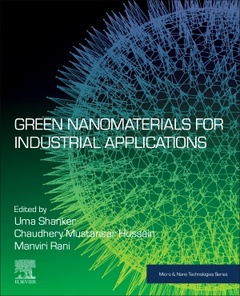Description
Green Nanomaterials for Industrial Applications
Micro and Nano Technologies Series
Coordinators: Shanker Uma, Rani Manviri, Mustansar Hussain Chaudhery
Language: English
Subjects for Green Nanomaterials for Industrial Applications:
582 p. · 19x23.4 cm · Paperback
Description
/li>Contents
/li>Biography
/li>Comment
/li>
Green Nanomaterials for Industrial Applications explores the applications of nanomaterials for a variety of industry sectors, along with their environmental impacts, lifecycle analysis, safety and sustainability. This book brings together the industrial applications of nanomaterials, covering new trends and challenges. Significant properties, safety and sustainability and environmental impacts of synthesis routes are also explored, as are major industrial applications, including agriculture, medicine, communications, construction, energy, and in the military. This book is an important information source for those in research and development who want to gain a greater understanding of how nanotechnology is being used to create cheaper, more efficient products.
Green nanomaterials have significant advantages including low cost, high efficiency, neutral environmental impact, and stability. Green Nanomaterials for Industrial Applications provides comprehensive information about green nanomaterials, their types, and methods for generation, characterization as well as their properties. Furthermore, this book also provides coverage of industrial scale fabrication methods for green nanomaterials and their applications for various industrial sectors at both experimental and theoretical models scales.
This book is an important reference source for materials scientists, engineers and environmental scientists who want to learn more about how sustainable nanomaterials are being used in a range of industrial applications.
1. Recent technologies for modern and future industry 2. Technological and economic barriers of industrial-scale production of nanocellulose 3. Synthesis, characterization, and their bio-interfaces for various biomedical applications 4. Synthesis of Green Nanoparticles for Biomedical Applications 5. Green biosynthesized metallic nanoparticles and future biomedical applications 6. Applications of green nanomaterials in Coatings 7. Chitosan-based Green Nanomaterials for Treatment of Textiles Industry Dyes 8. Sustainable Application of Nanomaterial for Finishing of Textile Material 9. Applications of green nanomaterials in Cosmetics Industry 10. Green nanomaterials as Photocatalysts: Current Trend 11. Application of Green Nano-Materials in Catalysis Industry 12. Waste derived biochar/carbon for various environmental and energy applications 13. Green Nanomaterials for Environmental Applications 14. Applications of green nanomaterials in electronic and electrical industries 15. Biodegradable Nanocomposite: A Promising Alternative of Synthetic Polymer in Electronic Industries 16. Potential of Green Nanoparticles for Sensing & Remediation of Heavy Metals from Mining Applications 17. Nanostructures Encapsulated Phase Change Materials for Sustained Thermal Energy Storage in Concrete 18. Toxicity and safety assessment of green nanomaterials 19. Graphene oxide and carbon dots: Synthesis, characterization, and their bio-interfaces for various biomedical applications
Manviri Rani is an expert in analytical method developments for various persistent organic pollutants. Her areas of research are analytical chemistry, environmental and green chemistry, persistent organic pollutants, plastic polymers and associated chemicals, chromatographic analysis, pesticide and polycyclic aromatic hydrocarbon analysis, solvent extraction, environment & health, and nanochemistry.
Chaudhery Mustansar Hussain is an adjunct professor and director of laboratories in the Department of Chemistry and Environmental Sciences at the New Jersey Institute of Technology (NJIT), Newark, New Jersey, United States. His research is focused on the applications of nanotechnology and advanced materials, environmental management, analytical chemistry, and other various industries.
- Explores industrial scale fabrication of green nanomaterials
- Assesses environmental, legal, health and safety aspects
- Discusses how green nanomaterials can be manufactured on an industrial scale




